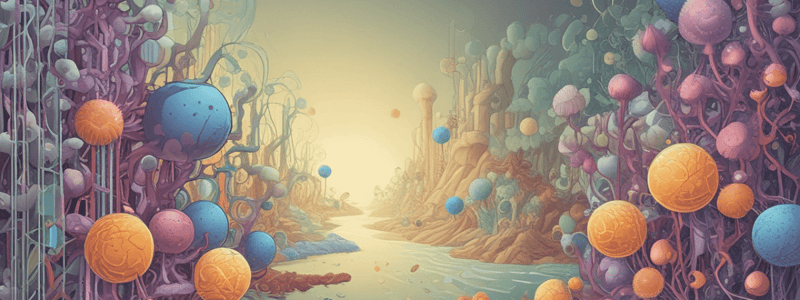Podcast
Questions and Answers
What is the characteristic of the prokaryotic cell wall?
What is the characteristic of the prokaryotic cell wall?
- Lack a cell wall
- Made of chitin
- Made of cellulose
- Contain peptidoglycan (correct)
Which of the following is a characteristic of prokaryotic cells?
Which of the following is a characteristic of prokaryotic cells?
- Presence of membrane-bound organelles
- Smaller in size (correct)
- Presence of nuclear membrane
- Organised replicative cell cycle
What is the function of the prokaryotic cell wall?
What is the function of the prokaryotic cell wall?
- To produce ATP
- To synthesize proteins
- To maintain cell shape (correct)
- To regulate cell growth
What is the difference between Gram (+) and Gram (-) bacteria?
What is the difference between Gram (+) and Gram (-) bacteria?
What is the primary characteristic of prokaryotic microorganisms?
What is the primary characteristic of prokaryotic microorganisms?
What is the component of archaeal cell walls?
What is the component of archaeal cell walls?
Which of the following microorganisms is NOT a type of prokaryote?
Which of the following microorganisms is NOT a type of prokaryote?
What is the shape of Vibrio cholerae?
What is the shape of Vibrio cholerae?
What is the name of the antibiotic discovered by Alexander Fleming in 1929?
What is the name of the antibiotic discovered by Alexander Fleming in 1929?
What is the role of fimbriae in prokaryotic cells?
What is the role of fimbriae in prokaryotic cells?
What is the process of cell division in prokaryotic cells?
What is the process of cell division in prokaryotic cells?
What is the term for the 40-day period that Venetian ships remained under quarantine before approaching Venice port?
What is the term for the 40-day period that Venetian ships remained under quarantine before approaching Venice port?
What is the primary function of Cyanobacteria?
What is the primary function of Cyanobacteria?
Which of the following is a characteristic of prokaryotic cells?
Which of the following is a characteristic of prokaryotic cells?
What is the system of naming living organisms invented by Carolus Linnaeus?
What is the system of naming living organisms invented by Carolus Linnaeus?
Which of the following is an example of a prokaryotic microorganism that lives in extreme conditions?
Which of the following is an example of a prokaryotic microorganism that lives in extreme conditions?
What is the main component of Gram-positive bacteria cell walls?
What is the main component of Gram-positive bacteria cell walls?
Which of the following is a characteristic of Gram-positive bacteria?
Which of the following is a characteristic of Gram-positive bacteria?
What is the function of the peptidoglycan layer in Gram-positive bacteria?
What is the function of the peptidoglycan layer in Gram-positive bacteria?
What is the composition of the outer membrane of Gram-negative bacteria?
What is the composition of the outer membrane of Gram-negative bacteria?
Which of the following bacteria is an example of Gram-negative bacteria?
Which of the following bacteria is an example of Gram-negative bacteria?
What is the difference between the cell walls of Gram-positive and Gram-negative bacteria?
What is the difference between the cell walls of Gram-positive and Gram-negative bacteria?
Why do Gram-positive bacteria stain purple in Gram staining?
Why do Gram-positive bacteria stain purple in Gram staining?
What is the function of the outer lipopolysaccharide layer in Gram-negative bacteria?
What is the function of the outer lipopolysaccharide layer in Gram-negative bacteria?
What is the main source of many antibiotics?
What is the main source of many antibiotics?
What is the disease caused by Clostridium tetani?
What is the disease caused by Clostridium tetani?
What is the name of the neurotoxin produced by Clostridium botulinum?
What is the name of the neurotoxin produced by Clostridium botulinum?
What is the result of botulinum toxin action at the neuromuscular junction?
What is the result of botulinum toxin action at the neuromuscular junction?
What is the cause of death in botulism?
What is the cause of death in botulism?
What is the characteristic of Mycoplasmas?
What is the characteristic of Mycoplasmas?
What is the disease caused by Bacillus anthracis?
What is the disease caused by Bacillus anthracis?
What is the name of the Gram-positive bacterium that contaminates improperly canned food?
What is the name of the Gram-positive bacterium that contaminates improperly canned food?
What type of flagella structure is found in Spirochetes?
What type of flagella structure is found in Spirochetes?
What is the function of the motor in a prokaryotic flagellum?
What is the function of the motor in a prokaryotic flagellum?
What is the name of the protein that makes up the filament in a prokaryotic flagellum?
What is the name of the protein that makes up the filament in a prokaryotic flagellum?
What is the type of motion exhibited by Spirochetes?
What is the type of motion exhibited by Spirochetes?
Where are the axial filaments located in Spirochetes?
Where are the axial filaments located in Spirochetes?
What is the location of the hook in a prokaryotic flagellum?
What is the location of the hook in a prokaryotic flagellum?
What determines the rotation direction of a prokaryotic flagellum?
What determines the rotation direction of a prokaryotic flagellum?
What is the function of the proton motive force in a prokaryotic flagellum?
What is the function of the proton motive force in a prokaryotic flagellum?
Flashcards are hidden until you start studying




